
The Temple in Jerusalem, or alternatively the Holy Temple, refers to the two religious structures that served as the central places of worship for Israelites and Jews on the modern-day Temple Mount in the Old City of Jerusalem. According to the Hebrew Bible, the First Temple was built in the 10th century BCE, during the reign of Solomon over the United Kingdom of Israel. It stood until c. 587 BCE, when it was destroyed during the Babylonian siege of Jerusalem. Almost a century later, the First Temple was replaced by the Second Temple, which was built after the Neo-Babylonian Empire was conquered by the Achaemenid Persian Empire. While the Second Temple stood for a longer period of time than the First Temple, it was likewise destroyed during the Roman siege of Jerusalem in 70 CE.

The Temple Mount, also known as The Noble Sanctuary, al-Aqsa Mosque compound, or simply al-Aqsa, and sometimes as Jerusalem's holyesplanade, is a hill in the Old City of Jerusalem that has been venerated as a holy site for thousands of years, including in Judaism, Christianity and Islam.
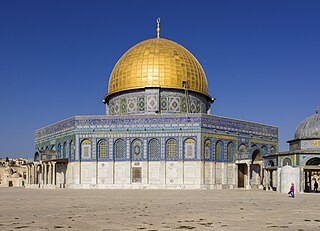
The Dome of the Rock is an Islamic shrine at the center of the Al-Aqsa mosque compound on the Temple Mount in the Old City of Jerusalem. It is the world's oldest surviving work of Islamic architecture, the earliest archaeologically attested religious structure to be built by a Muslim ruler and its inscriptions contain the earliest epigraphic proclamations of Islam and of the Islamic prophet Muhammad.

The Aqsa Mosque, also known as the Qibli Mosque or Qibli Chapel, is the main congregational mosque or prayer hall in the Al-Aqsa mosque compound in the Old City of Jerusalem. In some sources the building is also named al-Masjid al-Aqṣā, but this name primarily applies to the whole compound in which the building sits, which is itself also known as "Al-Aqsa Mosque". The wider compound is known as Al-Aqsa or Al-Aqsa mosque compound, also known as al-Ḥaram al-Sharīf.
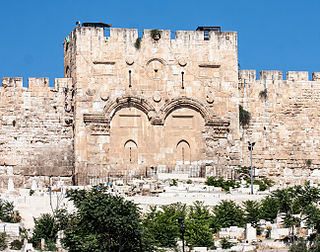
The Golden Gate or Gate of Mercy is the only eastern gate of the Temple Mount, and one of only two Gates of the Old City of Jerusalem that used to offer access into the city from the East side.

The Israʾ and Miʿraj are the two parts of a Night Journey that Muslims believe the Islamic prophet Muhammad took during a single night around the year AD 621. Within Islam, the majority of Islamic scholars claim that the journey was both a physical and spiritual one. Islamic tradition believes a brief mention of the story is found in the 17th surah (chapter) of the Quran, called al-Isra', while details of the story are found in the hadith.

Solomon's Stables, or Al-Marwani Mosque, is an underground vaulted prayer hall in the Al-Aqsa mosque compound in Jerusalem. It is 600 square yards in area, and is located under the southeastern corner of the compound, 12.5 m (41 ft) below the courtyard, and features twelve rows of pillars and arches. In December 1996 the Jerusalem Waqf renovated the area. The area was known to the Crusaders as Solomon's Stables, and to earlier Muslims as the Old Mosque.

The holiest sites in Islam are located in the Arabian Peninsula. While the significance of most places typically varies depending on the Islamic sect, there is a consensus across all mainstream branches of the religion that affirms two cities as having the highest degree of holiness, in descending order: Mecca, and Medina. Mecca's Al-Masjid al-Haram, and Al-Masjid an-Nabawi in Medina are all revered by Muslims as sites of great importance.

The Huldah Gates were one of the Gates of the Old City of Jerusalem leading into the Jerusalem Temple compound in the Hasmonean period and were named as such in the Mishnah. The term is currently being used for the remains of two later sets of gates, the Triple Gate and the Double Gate, known together as the Huldah Gates, built as part of the much extended Herodian Temple Mount, situated in Jerusalem's Old City. Both sets of gates were set into the Southern Wall of the Temple compound and gave access to the Temple Mount esplanade by means of underground vaulted ramps. Both were walled up in the Middle Ages.

The Temple Mount, a holy site in the Old City of Jerusalem, also known as the al-Ḥaram al-Sharīf or Al-Aqsa, contains twelve gates. One of the gates, Bab as-Sarai, is currently closed to the public but was open under Ottoman rule. There are also six other sealed gates. This does not include the Gates of the Old City of Jerusalem which circumscribe the external walls except on the east side.

The Dome of the Ascension is an Islamic free-standing domed structure built by the Umayyads that stands just north the Dome of the Rock on the al-Aqsa compound in Jerusalem.

The Islamic Museum is a museum at Al Aqsa in the Old City section of Jerusalem. On display are exhibits from ten periods of Islamic history encompassing several Muslim regions. The museum is west of al-Aqsa Mosque, across a courtyard.

A number of archaeological excavations at the Temple Mount—a celebrated and contentious religious site in the Old City of Jerusalem—have taken place over the last 150 years. Excavations in the area represent one of the more sensitive areas of all archaeological excavations in Jerusalem.

The Jerusalem Waqf and Al-Aqsa Mosque Affairs Department, also known as the Jerusalem Waqf, the Jordanian Waqf or simply the Waqf, is the Jordanian-appointed organization responsible for controlling and managing the current Islamic edifices on the Al-Aqsa mosque compound in the Old City of Jerusalem, known to Jews as the Temple Mount, which includes the Dome of the Rock.
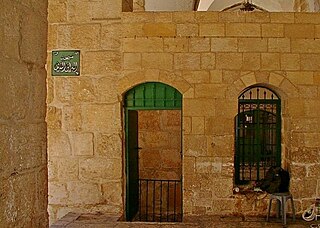
The al-Buraq Mosque is a subterranean musalla next to the Buraq Wall, near the southwest corner of the Masjid al-Aqsa compound in the Old City of Jerusalem. This mosque is called al-Buraq Mosque because of a ring that is nailed to its wall where Muslims believe Muhammad tied the Buraq that carried him from the al-Haram Mosque to the al-Aqsa Mosque during the Night Journey.

The Southern Wall is the retaining wall of the Temple Mount at the southern end. It was built during King Herod's expansion of the Temple Mount platform southward on to the Ophel.

The Royal Stoa was an ancient basilica constructed by Herod the Great during his renovation of the Temple Mount at the end of the first century BCE. Probably Herod's most magnificent secular construction, the three-aisled structure was described by Josephus as deserving "to be mentioned better than any other under the sun." The Royal Stoa overlooked Jerusalem's residential and commercial quarters, and at its southwestern corner was the place from which a ram's horn was blown to announce the start of holy days.
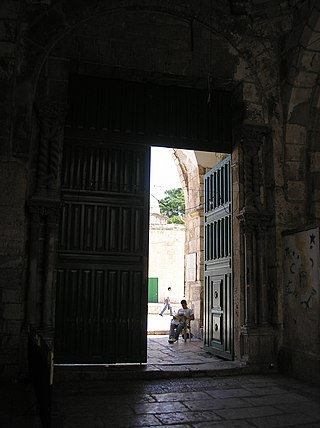
The Gate of the Chain or Chain Gate is one half of a double gate, part of the gates to the Al-Aqsa Mosque compound on the Temple Mount in the Old City of Jerusalem. It was known early Islamic period Bāb Daud, which means David's Gate. It was also known as Bāb al-Maḥkama, Gate of the Law Court, named after the nearby Maḥkama in the Tankiziyya building.
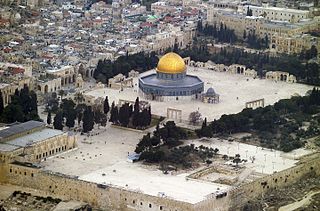
On 15 April 2022, clashes erupted between Palestinians and Israeli Security Forces on the Al-Aqsa compound in the Old City of Jerusalem. According to the United Nations Special Coordinator for the Middle East Peace Process, the clashes began when Palestinians threw stones, firecrackers, and other heavy objects at Israeli police officers. The policemen used tear gas shells, stun grenades and police batons against the Palestinians. Some Palestinians afterwards barricaded themselves inside the Al-Aqsa Mosque and proceeded to throw stones at the officers. In response, police raided the mosque, arresting those who had barricaded themselves inside. In addition, some damage was done to the mosque's structure.

Al-Aqsa or al-Masjid al-Aqṣā is the compound of Islamic religious buildings that sit atop the Temple Mount, also known as the Haram al-Sharif, in the Old City of Jerusalem, including the Dome of the Rock, many mosques and prayer halls, madrasas, zawiyas, khalwas and other domes and religious structures, as well as the four encircling minarets. It is considered the third holiest site in Islam. The compound's main congregational mosque or prayer hall is variously known as Al-Aqsa Mosque, Qibli Mosque or al-Jāmiʿ al-Aqṣā, while in some sources it is also known as al-Masjid al-Aqṣā; the wider compound is sometimes known as Al-Aqsa Mosque compound in order to avoid confusion.


















